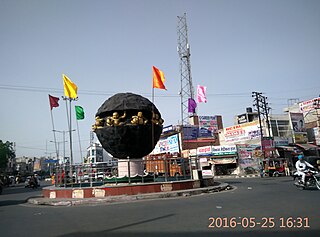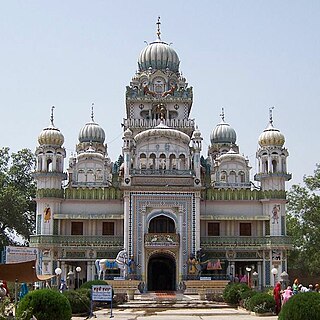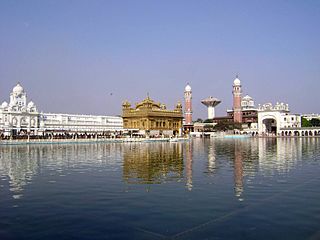Related Research Articles

Kaithal is a city and municipal council in the Kaithal district of the Indian state of Haryana. Kaithal was previously a part of Karnal district and later, Kurukshetra district until 1 November 1989, when it became the headquarters of the Kaithal. It shares a border with the Patiala district of state Punjab and the Kurukshetra, Jind and Karnal districts of Haryana. Kaithal district is situated in the North-West of the Haryana state. Its North-West boundaries, which include Guhla-Cheeka are attached to Punjab.

Anandpur Sahib, sometimes referred to simply as Anandpur, is a city in Rupnagar district (Ropar), on the edge of Shivalik Hills, Indian state of Punjab. Located near the Sutlej River, the city is one of the most sacred places in Sikhism, being the place where the last two Sikh Gurus lived, Guru Teg Bahadur Ji and Guru Gobind Singh Ji. this is the place where Guru Gobind Singh founded the Khalsa Panth in 1699. The city is home to Kesgarh Sahib Gurdwara, one of the five Takhts in Sikhism.

Chamkaur Sahib is a Sub Divisional town in the district of Rupnagar in the Indian State of Punjab. It is famous for the First Battle of Chamkaur (1702) and the Second Battle of Chamkaur (1704) fought between the Mughals and Guru Gobind Singh.

Paonta Sahib is an industrial town of Himachal Pradesh in India. It is located in the south of Sirmaur district, on National Highway 7. Paonta Sahib is an important place of worship for Sikhs, hosting a large Gurdwara named Gurudwara Paonta Sahib, on the banks of the river Yamuna. The river is the boundary between the states of Himachal Pradesh and Uttarakhand.

Sri Muktsar Sahib is a city and district headquarters for the district of Sri Muktsar Sahib, located in Punjab, India. The 2011 Census of India put the total population of Sri Muktsar Sahib municipality to 117,085, making it the 14th largest city of Punjab, in terms of population. Historically known as Khidrana or Khidrane di dhab, the city was made the district headquarters in 1995. Chronological evidence indicates that the city was named Muktsar after the battle of Muktsar in 1705. The government officially changed the name of the city to Sri Muktsar Sahib in 2012, though the city is still primarily referred to by its unofficial name – Muktsar.

Sikh Architecture is a style of architecture that was developed under Sikh Empire during 18th and 19th century in the Punjab region. Due to its progressive style, it is constantly evolving into many newly developing branches with new contemporary styles. Although Sikh architecture was initially developed within Sikhism its style has been used in many non-religious buildings due to its beauty. 300 years ago, Sikh architecture was distinguished for its many curves and straight lines; Shri Keshgarh Sahib and the Sri Harmandir Sahib are prime examples.
Gurdwara Mata Sundri is considered to be one of the major historical Gurudwara of the Sikh; it is a landmark on the Mata Sundri road in the heart of Delhi. It is situated behind JP Nayak Hospital, the Gurudwara is a tribute to Mata Sundri, the wife of the 10th Guru – Guru Gobind Singh [4].
German Sikhs are a religious minority in Germany. Many German Sikhs have their roots from the Punjab region in India. They number between 15,000 and 21,000. Germany had the third highest Sikh population in Europe after United Kingdom and Italy.

Gurudwara Paonta Sahib, is a noted Gurudwara in Paonta Sahib, District of Sirmour, Himachal Pradesh.

Gurdwara Mehdiana Sahib, also called the 'School of Sikh History' is a Sikh gurdwara located in the village of Mehdiana, just outside Mallha,near Jagraon in Ludhiana district, India.

Gurdwara Damdama Sahib is a gurdwara located near Humayun's Tomb on the Outer Ring Road in New Delhi, India.

Kiratpur also known as Kiratpur Sahib is a town in Rupnagar district, Punjab, India. The town is the location of the Gurdwara Patal Puri where Sikhs take ashes of their deceased.

Gurdwara Fatehgarh Sahib is a Sikh gurdwara or place of worship in the city of Fatehgarh Sahib in the Indian state of Punjab. The gurdwara marks the 1710 conquest of the city by the Sikhs under the leadership of Banda Singh Bahadur. Sikhs captured the area and razed the fort built by Ferozshah Tughlaq to the ground.

Hazur Sahib, also known as Takht Sachkhand Sri Hazur Abchalnagar Sahib, is one of the five takhts in Sikhism. The gurdwara was built between 1832 and 1837 by Nasir-ud-Daulah, Asaf Jah IV upon the request of his friend Maharaja Ranjit Singh (1780–1839) to build the gurudwara. It is located on the banks of the Godavari River at the city of Nanded in the state of Maharashtra, India.

A takht, or taḵẖata literally means a throne or seat of authority and is a spiritual and temporal centre of Sikhism. There are five Takhts, which are five gurudwaras that have a very special significance for the Sikh community. The first and the most important was established by Guru Hargobind in 1609, 'Akal Takht' and is just opposite the gate of Harmandir Sahib – The Golden Temple, Amritsar. While the Harmandir Sahib, or Golden Temple, represents Sikh spiritual guidance, the Akal Takht symbolizes the dispensing of justice and temporal activity. It is the highest seat of temporal authority of the Khalsa and the seat of the Sikh religion's earthly authority. There, the Guru held his court and decided matters of military strategy and political policy. Later on, the Sikh Nation took decisions here on matters of peace and war and settled disputes between the various Sikh groups. The Sarangi singers sung the ballads of the Sikh Gurus and warriors at the place and robes of honour (saropas) were awarded to persons who rendered distinguished services of the community of men in general. In December 2010, the Deccan Odyssey train, taken on charter from Government of Maharashtra, started with the aim to have a journey across four Sikh takhts, with a flight by devout and sightseers to the fifth takht. A special train named Panj Takht Special train for the pilgrimage of five Sikh takhts, was flagged off on 16 February 2014.

Patna City, popularly known as Patna Saheb or Patna Sahib, is a neighbourhood in Patna, Bihar, India. It is regarded as very sacred by the Sikhs in India. The tenth Guru of the Sikhs, Guru Gobind Singh was born there. The Patna Saheb Gurudwara is considered to be one of the holiest of the five "Takhts" or seat of authority of the Sikhs. The place is named Harminder Takht though the Sikhs respectfully call it Patna Sahib. The famous Guru Gobind Sahib Gurudwara is an important shrine for Sikhs from all over the world. Ashok Rajpath (road) connects Patna City to Patna.
The list of noted Sites related to creation Dasam Granth Sahib.

Guru Nanak Jhira Sahib is a Sikh historical shrine situated in Bidar, Karnataka. Gurdwara Nanak Jhira Sahib was built in the year 1948 and is dedicated to the first Sikh guru Guru Nanak. Bidar has a very long association with Sikhism as this is the home town of Bhai Sahib Singh, one of the Panj Pyare, who offered to sacrifice their heads and were later baptised as the first members of the Khalsa.

The 350th Prakash Parv or birth anniversary of Guru Gobind Singh ji was celebrated in January 2017 in Patna, India. 2017 is the year of the 350th anniversary of the 10th Sikh Guru, a spiritual master, warrior, poet and philosopher. At the date of this anniversary, a number of events was organized on the occasion in Patna marking a grand celebration in their history.
References
- ↑ "Gurdwara Koohni Sahib - SikhiWiki, free Sikh encyclopedia". www.sikhiwiki.org.
- ↑ "Koohni Sahib Gurdwara - Chandigarh Kuhni Sahib Gurdwara - Gurudwara Bageecha Sahib Near Chandigarh". www.chandigarh.co.uk.
- ↑ "Gurdwara Koohni Sahib, Chandigarh". www.nativeplanet.com.
- ↑ "Historical Gurudwaras". www.historicalgurudwaras.com.
- ↑ "Gurudwara Koohni Sahib, Panchkula". World Gurudwaras.